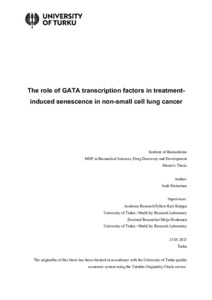The role of GATA transcription factors in treatment-induced senescence in non-small cell lung cancer
Hietarinne, Juuli (2023-05-29)
The role of GATA transcription factors in treatment-induced senescence in non-small cell lung cancer
Hietarinne, Juuli
(29.05.2023)
Julkaisu on tekijänoikeussäännösten alainen. Teosta voi lukea ja tulostaa henkilökohtaista käyttöä varten. Käyttö kaupallisiin tarkoituksiin on kielletty.
avoin
Julkaisun pysyvä osoite on:
https://urn.fi/URN:NBN:fi-fe20230828111700
https://urn.fi/URN:NBN:fi-fe20230828111700
Tiivistelmä
Lung cancer is one of the leading causes of cancer-related deaths. The most common subtype, non-small cell lung cancer (NSCLC), is still mostly uncurable. Therapies targeting driver mutations are effective initially, however, over time therapy resistance inevitably evolves. NSCLC cells surviving targeted therapy have a senescent phenotype and treatment-induced senescence has been suggested to play a role in therapy resistance. Besides their role in embryonic development, GATA transcription factors have also been shown to induce senescence.
The project aimed to assess the role of GATA transcription factors, especially GATA6, in treatment-induced senescence. Doxycycline-inducible expression of GATA transcription factors was successfully established in NSCLC cells, HCC827, using lentiviral vectors. Successful transduction was confirmed with Western blotting. The effects of GATA transcription factor expression on apoptosis during early treatment were assessed by live cell imaging with IncuCyte S3, whereas the effects on cell survival after long-term targeted therapy were determined using a CellTiter-Glo® cell viability assay. Finally, the effects on senescence were studied with senescence-associated β-galactosidase staining and RT-qPCR.
The overexpression of GATA6 decreased cell survival following long-term targeted therapy without inducing apoptosis during early treatment. Additionally, overexpression of GATA6 increased the expression of senescence-related genes, however, senescence-associated β-galactosidase activity was not observed. Silencing of GATA6 both induced apoptosis during early treatment and decreased cell survival following long-term targeted therapy. GATA6 silencing also decreased the proportion of β-galactosidase-positive cells and the expression of senescence-related genes in long-term assays.
Taken together, GATA6 alone is not sufficient to induce senescence, however, it may have a role in treatment-induced senescence in NSCLC. Further research is needed to assess this phenomenon and elucidate the role of GATA6 in treatment-induced senescence and therapy resistance.
The project aimed to assess the role of GATA transcription factors, especially GATA6, in treatment-induced senescence. Doxycycline-inducible expression of GATA transcription factors was successfully established in NSCLC cells, HCC827, using lentiviral vectors. Successful transduction was confirmed with Western blotting. The effects of GATA transcription factor expression on apoptosis during early treatment were assessed by live cell imaging with IncuCyte S3, whereas the effects on cell survival after long-term targeted therapy were determined using a CellTiter-Glo® cell viability assay. Finally, the effects on senescence were studied with senescence-associated β-galactosidase staining and RT-qPCR.
The overexpression of GATA6 decreased cell survival following long-term targeted therapy without inducing apoptosis during early treatment. Additionally, overexpression of GATA6 increased the expression of senescence-related genes, however, senescence-associated β-galactosidase activity was not observed. Silencing of GATA6 both induced apoptosis during early treatment and decreased cell survival following long-term targeted therapy. GATA6 silencing also decreased the proportion of β-galactosidase-positive cells and the expression of senescence-related genes in long-term assays.
Taken together, GATA6 alone is not sufficient to induce senescence, however, it may have a role in treatment-induced senescence in NSCLC. Further research is needed to assess this phenomenon and elucidate the role of GATA6 in treatment-induced senescence and therapy resistance.
